Just like people have preferences for what games they play and activities they do, the same is true for our dogs. Not every dog will enjoy playing the same way or appreciates the same type of toys. When choosing toys and activities for your dog, here are some considerations to keep in mind:
Size of Toys:
Most importantly, when picking toys and activities, you’ll want to consider the size of your dog relative to the size of the toys you are looking at. Toys too small for your dog can present a severe choking hazard. If swallowed, toys can also cause intestinal obstruction, requiring emergency surgery to remove them. Pick toys that are large enough that your dog can’t swallow and durable enough for your dog. If you have a serious chewer dog, you’ll especially need to pick toys that can hold up to your dog’s playstyle. Even if you pick appropriately sized toys for your dog, it’s essential to supervise your dog while playing with toys and remove any toys that get damaged or splintered.
Fitness Levels:
When selecting toys and activities to get your dog involved, consider your dog’s level of physical fitness. Some sports and activities will be best for dogs with a high physical fitness level. In contrast, other activities are appropriate for all dogs, including quieter or less physically fit dogs. For example, brachycephalic dogs like Pekingese and French Bulldogs likely won’t be a good match for sports like dock diving as these flat-faced breeds need special care near water and should always wear a life jacket.
Similarly, if you have a senior dog who has arthritis, high-impact dog sports like agility and flyball probably aren’t a great option. Instead, you might want to consider Rally Obedience or Scent Work as more appropriate lower-impact sports that your dog can enjoy and be successful with. If you aren’t sure if an activity will be a good fit for your dog, speak with your dog’s veterinarian to discuss if any limits on your dog’s activity or sports won’t be a good fit.
Play Styles:
Although you can teach your dog to play in different ways, most dogs have play styles that are natural for your dog. Consider your dog’s play styles when selecting new toys and activities. If your dog loves to tug, be sure to purchase durable toys designed for your dog to pull and yank on in engaged play with you. On the other hand, if you have a dog who lives for a good game of fetch, select toys that are easy for you to throw. If you have a dog who is uncertain about toys or hasn’t historically shown much interest in toys, consider adding some toys that you can fill with treats or some of your dog’s UnKibble. Food-filled toys can be an ideal way to encourage dogs to start exploring toys.
Solo vs. Cooperative Play:
When selecting toys for your dog, try to choose toys that encourage independent and cooperative play. Independent play toys are those toys that are designed for your dog to play with on their own. These independent play toys can include snuffle mats, food puzzles, and squeaky toys. On the other hand, cooperative play toys are made for dogs and people to enjoy together, like tug and fetch toys.

Toy Diversity:
When choosing toys for your dog, it can also be helpful to consider what toys your dog already has. Some dogs are very particular about their toys and will only play with one type of toy or, in extreme cases, one specific toy. However, most dogs enjoy a variety of toys. When picking toys for your dog, look at toys that make different sounds and are made of various materials. You can also seek toys that encourage your dog to engage in multiple types of play. Having a wide range of toys available for your dog to play with can help to decrease boredom by providing ongoing enrichment in your dog’s day and environment.
Temperament Considerations:
Consider your dog’s temperament and activity level when thinking about activities your dog will like. If you have a dog who is comfortable and social with other dogs and people, you might want to consider bringing your dog to different sports classes and fun days where you can have the opportunity to try different dog sports and activities. On the other hand, if your dog is reactive or is nervous about being in groups, you might want to focus on sports and activities that you can do virtually or in smaller groups. Most sports instructors will offer options for private lessons or virtual instruction if a group class isn’t a good fit for your dog. This can allow your dog to play a sport without the triggers/stressors of a group class environment.




















